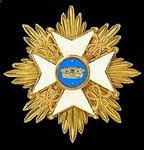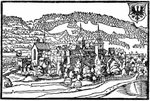As my Légion Britannique flags have been popping up here and there (used by people who have had the sheets emailed to them by me) and there has consequently been more interest I thought I'd make the infantry flags more easily available here on the blog. We know that the Légion used British style flags but have no images of them so I created my version based on British flag regulations of the Seven Years War. There is also a sheet of dragoon guidons, but it is too big a file to be put on the blog, so if anyone wants that they will still have to contact me so I can email it to them.
The Légion Britannique was raised for service in the Hanoverian Army in
1760. It was paid for by the British government and carried
flags of British pattern, although its officers were Hanoverian. It
consisted of 5 battalions, each of 4 infantry companies and a dragoon
squadron; the strength of each battalion was intended to be 500 infantry
and 101 dragoons.
As the Légion was raised from deserters,
foreigners and sometimes prisoners of war, its quality can be imagined,
and losses from desertion and capture were many. Despite its
inauspicious make up, units of the Légion were capable of distinguished
service, as with the 3rd battalion which fought well in the defence of
Hamm in 1761 and the 2nd battalion which was overcome at the defence of
Meppen only after a fierce resistance. French prisoners taken at Warburg
in July 1760 were later enlisted in the Légion's light companies. Near the end of the war the Légion was taken into Prussian service, which cannot have pleased many of its troops!
And here is the dragoon guidon sheet, in very low resolution; the actual sheet is nearly 4 MBs and too big to post here. If anyone would like a copy, please let me have an email address via the Contact Form (don't put your email address in the comments as you really don't want it to be picked up by bots and to be spammed!).





















